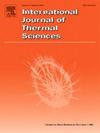Smoldering fire potential in activated carbons based on surface temperature and carbon monoxide emission
IF 4.9
2区 工程技术
Q1 ENGINEERING, MECHANICAL
International Journal of Thermal Sciences
Pub Date : 2025-03-22
DOI:10.1016/j.ijthermalsci.2025.109877
引用次数: 0
Abstract
Activated carbon has a large surface area and high porosity, which makes it an excellent adsorbent for the removal of industrial pollutants. However, it is associated with significant fire risk including smoldering and auto-ignition because adsorption is an exothermic reaction. Although smoldering is a slow, low-temperature combustion mode, it produces large amounts of toxic gases and can transition into flaming combustion. Therefore, elucidating the combustion characteristics of smoldering activated carbon is important for ensuring fire safety in industrial settings. In this study, the combustion characteristics of activated carbons with different types were investigated under several external heat fluxes. The onset of smoldering was determined based on its characteristic temperature obtained from thermogravimetric analysis. The reaction progression and combustion stages were presented in terms of surface temperature distributions and carbon monoxide emissions during thermal reactions. Additionally, the effects of changes in the exposed surface area and thickness on the combustion behavior of activated carbon were analyzed. Finally, the potential for flame occurrence via the gas-phase reaction during smoldering was examined.
基于表面温度和一氧化碳排放的活性炭的阴燃火灾电位
活性炭的表面积大,孔隙率高,是去除工业污染物的优良吸附剂。然而,由于吸附是一种放热反应,它与包括阴燃和自燃在内的重大火灾风险有关。虽然阴燃是一种缓慢、低温的燃烧方式,但它会产生大量有毒气体,并可能转变为火焰燃烧。因此,阐明阴燃活性炭的燃烧特性对于确保工业环境中的防火安全具有重要意义。研究了不同类型活性炭在不同外加热通量下的燃烧特性。根据热重分析得到的特征温度确定了阴燃的开始。从热反应的表面温度分布和一氧化碳排放的角度描述了反应过程和燃烧阶段。此外,还分析了暴露表面积和厚度的变化对活性炭燃烧性能的影响。最后,对阴燃过程中气相反应发生火焰的可能性进行了分析。
本文章由计算机程序翻译,如有差异,请以英文原文为准。
求助全文
约1分钟内获得全文
求助全文
来源期刊

International Journal of Thermal Sciences
工程技术-工程:机械
CiteScore
8.10
自引率
11.10%
发文量
531
审稿时长
55 days
期刊介绍:
The International Journal of Thermal Sciences is a journal devoted to the publication of fundamental studies on the physics of transfer processes in general, with an emphasis on thermal aspects and also applied research on various processes, energy systems and the environment. Articles are published in English and French, and are subject to peer review.
The fundamental subjects considered within the scope of the journal are:
* Heat and relevant mass transfer at all scales (nano, micro and macro) and in all types of material (heterogeneous, composites, biological,...) and fluid flow
* Forced, natural or mixed convection in reactive or non-reactive media
* Single or multi–phase fluid flow with or without phase change
* Near–and far–field radiative heat transfer
* Combined modes of heat transfer in complex systems (for example, plasmas, biological, geological,...)
* Multiscale modelling
The applied research topics include:
* Heat exchangers, heat pipes, cooling processes
* Transport phenomena taking place in industrial processes (chemical, food and agricultural, metallurgical, space and aeronautical, automobile industries)
* Nano–and micro–technology for energy, space, biosystems and devices
* Heat transport analysis in advanced systems
* Impact of energy–related processes on environment, and emerging energy systems
The study of thermophysical properties of materials and fluids, thermal measurement techniques, inverse methods, and the developments of experimental methods are within the scope of the International Journal of Thermal Sciences which also covers the modelling, and numerical methods applied to thermal transfer.
 求助内容:
求助内容: 应助结果提醒方式:
应助结果提醒方式:


